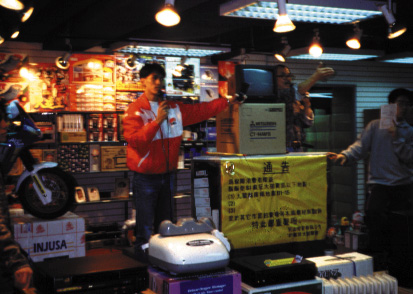 Bidding up from $1
Bidding up from $1An anti-inflationary auction stimulates public consumption



 Bidding up from $1
Bidding up from $1
An anti-inflationary auction stimulates public consumption
by Amy Tse
 Left: An auctioneer calls out prices to the highest-bidders.
Left: An auctioneer calls out prices to the highest-bidders.
|
“Good afternoon every- body. It is easy to buy cheap things here. Don’t hesitate to raise your hands. Have refund if you later find the products not suitable for you. . . .” With this eloquent speech, an auction is started.
But no antiques or land is auctioned off. Besides, the highest bidders are not business giants. Most are housewives hunting for cheap electrical appliances and family household goods. This is the $1 auction market at Kowloon City Plaza, where transactions at extremely low prices are feasible.
Mr. Tony Mok, the administration manager of Sky Mount Investment Limited, which runs the market, traces the origin of the $1 auction.
Said he: “It was originated in the United States and introduced to the domestic market about 10 years ago. Now six companies with 20 branches are running this kind of business.”
According to Mr. Mok, auctioneers play an important role in the popularity of the $1 auction.
He said, “A skilful auctioneer can create a funny and light-hearted atmosphere, thus attracting customers and stimulating their purchasing motives.”
A “Mrs. Mak”, 33, who refused to reveal her real name, is a housewife of Kowloon City. She said, “Even if you intend to buy nothing, just sitting here and listening to the amusing speech of the auctioneer is enjoyable.”
Nevertheless, Mrs. Mak brought $1,000 with her in case she sees a microwave oven.
Ms Mimi Lok, another customer of Choi Hung, said, “I have seen a little girl who bought a Barbie doll at $1. Although it may be a fake, its price was incredibly low.”
The low prices at the auction are explained by Mr. Mok: “Certainly, $1 can hardly cover the production costs. Yet, the promotional effect of selling goods cheaply is much greater than advertising in TV commercials.
“We buy electrical appliances and toys from wholesalers in bulk. Most models are outdated in local markets. Suppliers are therefore willing to give us a discount,” added Mr. Mok.
Because of the cheap goods, Ms Lok said customers sometimes buy useless things here.
Said she: “Involved in the excitement of the auction, customers make irrational decisions easily. I once bought an electrical fan for only $80. However, it is scarcely used by my family and is left idle now.”
Nevertheless, Ms Lok complained about the quality of products at the auction at times.
“I bought a cordless iron at $150. Yet, it cools down quickly after being unplugged. Its quality hardly matched the auctioneer’s description.”
Another customer, Mrs. Leung, who requested that her full name be withheld, said, “I dare not buy electrical appliances here. The auctioneer introduces the products so quickly that I don’t have time to check the goods.
“Nevertheless, the quality of the toys I have bought for my daughter is good,” added Mrs. Leung.
Onstage, the auctioneer announces loudly, “$800 once. . . ! $800 twice. . . ! $800 third time. . . ! Deal!” Mrs. Mak successfully bought the microwave oven.
“I need not take it home myself. Their free delivery service will send me the oven within the week,” said Mrs. Mak satisfactorily.
Mr. Pak, who refused to reveal his full name, had been employed by a $1 auction market several years ago. He said some of these markets are deceiving customers.
He gave an example: “Before the auction started, other staff told me the minimum prices of different goods. I then pretended to be a customer. If the bidding prices offered by real customers were unsatisfactory, I would raise my hand to bid up the prices. This was common for transaction of electrical appliances, but inexpensive items like toys were not our concern.”


